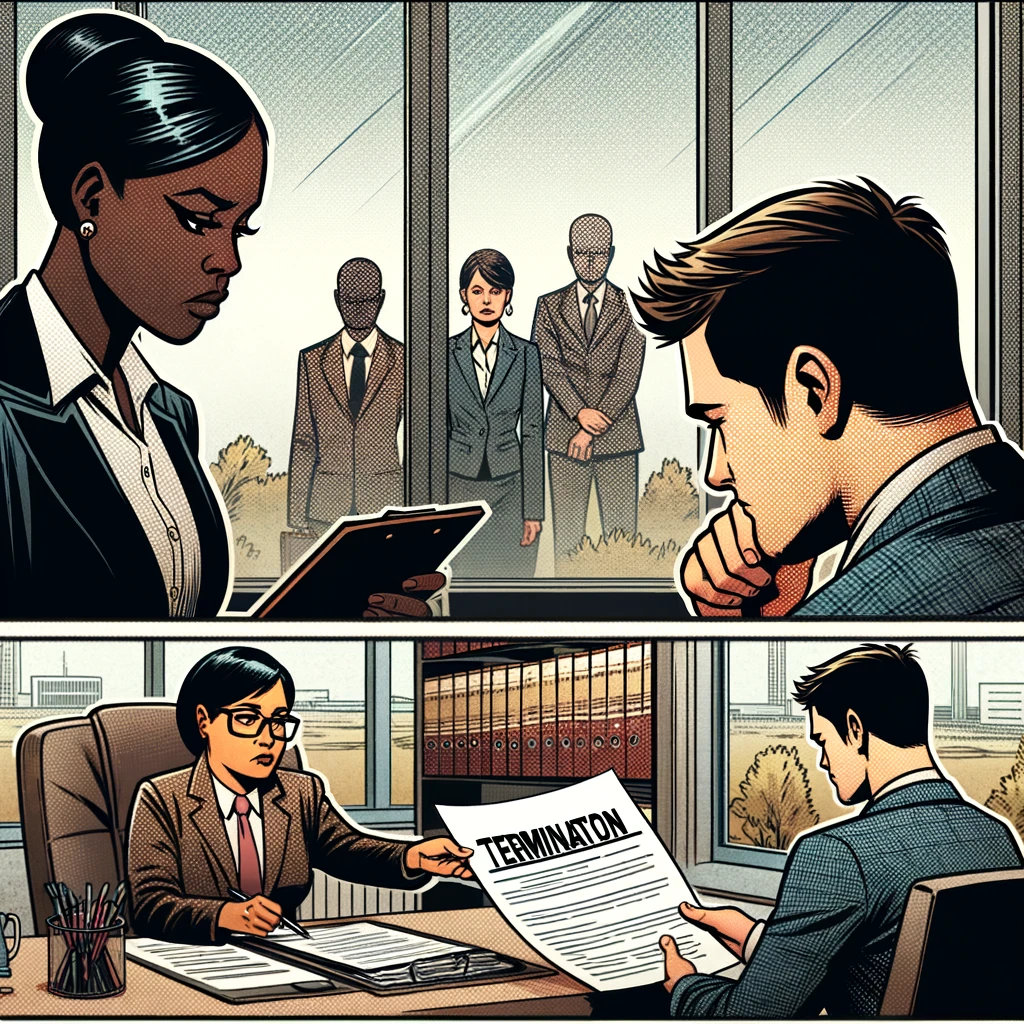Estimated reading time: 8 mins
Firing an employee is undoubtedly one of the most challenging aspects of management. Not only does it have profound implications for the individual being let go, but it also impacts the team and the overall morale of the organization. Nevertheless, there are circumstances where dismissing an employee becomes unavoidable due to performance issues, misconduct, or economic constraints faced by the company. Handling this delicate situation requires tact, legality, and compassion. This guide will outline a comprehensive approach in how to fire somebody in a way that maintains dignity for all parties involved and minimizes the negative impacts.

The decision to terminate an employee is never taken lightly. It marks a significant transition for both the individual and the company and often comes after multiple attempts to rectify the underlying issues through performance reviews, corrective actions, and personal coaching. The process of firing someone can be fraught with emotional tension and potential legal pitfalls. Thus, it is essential that it be conducted with the utmost respect for the legal rights of the employee and the procedural norms of the company. Effective handling not only ensures compliance with employment laws but also safeguards the company’s reputation and supports a healthy workplace culture. This post aims to provide managers with practical advice on navigating this complex process responsibly and empathetically.
1. How to Fire Somebody: Ensure a Solid Ground for Termination
Before taking any action to terminate an employee, it’s crucial to ensure that there is a solid, justifiable reason for the dismissal. This involves having documented evidence of issues such as poor performance, policy violations, or other misconduct. Thorough documentation should include performance reviews, written warnings, and any relevant communications that illustrate a history of the problems being addressed but not resolved. Employers must ensure that the evidence is concrete and quantifiable to avoid subjective interpretations that could lead to legal challenges.
Additionally, when learning how to fire somebody it’s essential to confirm that the employee had been made aware of the expectations and given a fair opportunity to improve. This step not only justifies the termination decision but also aligns with ethical management practices by showing that the decision was not made hastily or without proper cause. By establishing a solid foundation for termination, you protect the organization from potential legal repercussions and ensure that the process is fair and justified.
2. How to Fire Someone: Consult with Human Resources
Once you have substantiated the grounds for dismissal, the next step is to consult with the Human Resources (HR) department. HR will review the case to ensure all legal and organizational policies have been followed and advise on the best practices for conducting the termination meeting. They can also assist in handling the paperwork and logistical aspects, such as final paychecks and benefits information.
HR’s involvement is crucial as they provide a layer of oversight and support to ensure the process is not only legally compliant but also adheres to the best human resource management practices. Their expertise helps safeguard the company against potential legal liabilities and ensures that the termination process is handled with the highest level of professionalism and fairness. Additionally, HR can provide training and support to managers on how to conduct effective and respectful termination meetings, which is vital in maintaining a positive workplace environment even during challenging situations like these.
3. How to Fire Somebody: Prepare for the Meeting
Preparation is key to handling a firing with professionalism. Plan what you will say ahead of time, keeping your language clear and direct. When learning how to fire somebody, prepare yourself to answer any questions the employee may have about the reasons for their dismissal and their next steps. It’s also advisable to schedule the meeting at a time and place that allows for privacy and dignity, typically at the end of the workday to minimize the employee’s embarrassment and disruption to the workplace.
Additionally, prepare documentation to provide to the employee during the meeting, including details about their termination, severance, benefits, and any company property they need to return. This preparation not only makes the meeting more manageable but also demonstrates respect for the employee by ensuring that all information is communicated clearly and professionally. Such thorough preparation can help reduce the emotional impact on both parties and streamline the overall process, making it as respectful and dignified as possible.


4. How to Fire Someone: Conduct the Termination Meeting
During the meeting, it’s important to be compassionate yet firm. Clearly explain the reasons for the termination, sticking to the facts and avoiding unnecessary details that could inflame the situation. Allow the employee to express their thoughts but steer the conversation gently yet firmly if emotions start to escalate. Having a representative from HR present during the meeting can help keep the process on track and ensure all legal and procedural guidelines are followed. This presence can also provide support for both you and the employee, offering a sense of fairness and objectivity to the proceedings.
It’s crucial to maintain a professional demeanor throughout the meeting, focusing on the issue at hand and not allowing personal feelings to color the interaction. By conducting the meeting with clarity and sensitivity, you can help the employee understand the decision, potentially easing their transition out of the company while protecting the integrity of the process and minimizing potential fallout.
5. How to Fire Somebody: Offer Support and Resources
Where possible, offer support to the departing employee in the form of outplacement services, which can help them find new employment. Providing a reference for future jobs (if appropriate) or information about unemployment benefits can also ease the transition. This not only helps the employee leave with their dignity intact but also reflects well on your company’s culture. By offering practical help and showing compassion, you mitigate the negative impact of the termination and demonstrate that the company values its employees, even in difficult situations.
This approach can enhance your reputation as a fair and caring employer, which can be beneficial for both current employee morale and your brand’s perception in the broader market. Additionally, such support can help the departing employee maintain a positive relationship with your company, potentially reducing the risk of legal disputes and fostering goodwill in your professional network.
6. How to Fire Someone: Communicate the Decision to the Team
After the termination, communicate this change to your team without going into inappropriate detail. It’s important to address any impacts on workflow and reassure your team about their job security and the reasons for the dismissal in a way that respects everyone’s privacy and emotions. This communication should foster transparency and prevent the spread of rumors, which can damage morale. Provide clear guidance on how responsibilities will be reallocated and express your confidence in the team’s ability to handle these changes.
Additionally, offer support and an open-door policy for any team members who may have concerns or need help adjusting to the new dynamics. Properly managing this communication not only helps maintain stability and morale within the team but also reinforces a culture of trust and respect, crucial for a healthy workplace environment.


7. How to Fire Somebody: Learn from the Experience
After the firing process, reflect on what led up to it. Consider if there were any management or organizational failures that allowed the situation to deteriorate and whether improvements can be made in training, hiring practices, or performance reviews. This reflection can help you develop your skills in how to fire somebody, prevent future terminations and contribute to a healthier, more productive work environment. Evaluate the effectiveness of your performance management systems and consider whether employees have clear job descriptions, adequate resources, and regular feedback on their performance.
Learning from each termination case can lead to better management practices that not only improve employee satisfaction and performance but also reduce the likelihood of future dismissals. Such proactive measures can strengthen your organization, enhancing both employee retention and the overall operational efficiency.
8. How to Fire Someone: Provide Emotional Support for the Management Team
Firing an employee can be emotionally taxing, not just for the employee being let go but also for the person who has to conduct the firing. Managers should have access to support, such as discussions with HR or counseling if needed, to process their feelings and learn how to handle such situations better in the future. This support can help managers deal with the stress and potential guilt associated with firing someone, ensuring they remain effective in their roles.
Additionally, training on how to handle difficult conversations and employee terminations can be invaluable, equipping managers with the skills needed to conduct these meetings with confidence and empathy. By providing emotional support and appropriate training, organizations can help their leadership maintain their well-being and morale, which is crucial for sustaining a positive and productive work environment.
Conclusion
In conclusion, firing an employee is a complex and sensitive task that requires careful handling to ensure it is done professionally and compassionately. By preparing thoroughly, communicating clearly, and providing support to both the employee being terminated and the team remaining, managers can conduct this difficult process in a way that maintains dignity for all parties involved. It’s also crucial to learn from each termination experience to improve future management and organizational practices. This approach not only minimizes the negative impacts of termination but also reinforces a culture of respect and fairness within the organization. Ensuring a thoughtful termination process reflects well on the company, helps preserve its reputation, and contributes to a positive and supportive workplace environment.

